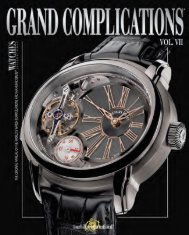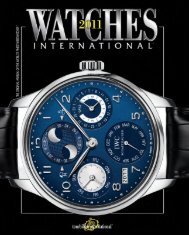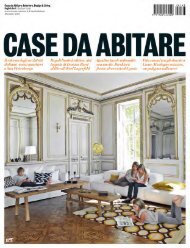180 YEARS OF
180 YEARS OF
180 YEARS OF
You also want an ePaper? Increase the reach of your titles
YUMPU automatically turns print PDFs into web optimized ePapers that Google loves.
1977<br />
Response to<br />
the Quartz<br />
Crisis<br />
CALIBER L990<br />
It took courage to launch a new<br />
automatic caliber in 1977. Aer two<br />
years of research and development<br />
work, Longines presented the ‘E’<br />
caliber family, which was later renamed<br />
L990. Just 2.95 millimeters<br />
thick, it was the world’s slimmest<br />
movement with two barrels and automatic<br />
winding via a central rotor.<br />
Its most notable characteristic was a<br />
pair of serially arranged barrels that<br />
had made their debut in automatic<br />
Caliber L890 in 1975. e energy<br />
and rotational speeds of the two<br />
barrels combined to produce a 44hour<br />
power reserve. e comparatively<br />
quickly turning mainsprings<br />
had lower torques: this signicantly<br />
reduced the force exerted on the<br />
gear train while at the same time<br />
achieving superior performance.<br />
84 | WatchTime LONGINES SPECIAL<br />
is solution made it possible to<br />
lower the transmission ratio of the<br />
train between the rotor and the barrels,<br />
while also enabling the engineers<br />
to eliminate one gear and to<br />
reduce both the weight and the<br />
thickness of the ball-borne rotor.<br />
anks to the simplicity of its architecture,<br />
the entire self-winding<br />
assembly could be positioned below<br />
the barrel bridge as an integral<br />
component of the movement. ere<br />
were four caliber versions: L990<br />
with central seconds and date display;<br />
L992 with central seconds but<br />
without a date display; L993 with<br />
date display but without a secondhand;<br />
and L994 with hands only for<br />
hours and minutes. Breguet, which<br />
like Longines is part of the Swatch<br />
Group, now owns rights of this caliber,<br />
to which it has given a silicon<br />
escapement and the name “591A.”<br />
1979<br />
Paper-in<br />
GOLDEN LEAF<br />
Japanese watch companies seized the<br />
lead from the Swiss in the development<br />
of thin electronic movements in<br />
1978. Longines, a pioneer in the world<br />
of quartz watches, refused to take this<br />
lying down, so the brand joined with<br />
its sister company ETA and other<br />
members of the Allgemeine Schweizerische<br />
Uhren AG (ASUAG) to<br />
launch an ambitious project called<br />
“Delirium.” The goal was not only to<br />
break records, but also to overcome<br />
the severe crisis that faced<br />
the Swiss watch industry<br />
at the time.<br />
Longines’s management<br />
celebrated a<br />
spectacular success<br />
on January 12,<br />
1979, when it introduced<br />
the world’s<br />
slimmest quartz<br />
wristwatch with an<br />
analog time display<br />
and an overall height<br />
of just 1.98 millimeters.<br />
The brand launched<br />
this timepiece under the<br />
appealing name, Golden<br />
Leaf. The technicians<br />
who created its movement,<br />
Caliber L795.2, had radically<br />
departed from conventional<br />
principles of construction. The<br />
case’s back doubled as its base<br />
plate. After assembling the<br />
movement and inserting the<br />
hands, watchmakers needed only<br />
to install the bezel and the crystal<br />
above the dial. The hands could be<br />
reset by pressing a little button in the<br />
back of the slender, golden case.<br />
WWW.WATCHTIME.COM

















